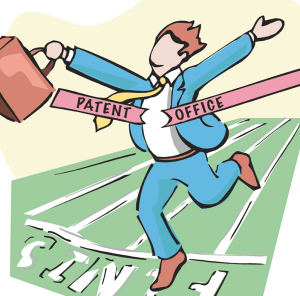The Race to the Patent Office
‘First-to-file System’ Represents a Significant Change in the Rules
 On March 16, the U.S. patent system changed from what’s known as a ‘first-to-invent’ system to a ‘first-to-file’ system. This significant change means that only the first person to file a patent application on an invention can receive a patent, with few exceptions.
On March 16, the U.S. patent system changed from what’s known as a ‘first-to-invent’ system to a ‘first-to-file’ system. This significant change means that only the first person to file a patent application on an invention can receive a patent, with few exceptions.
In other words, an inventor can race to the U.S. Patent and Trademark Office (the Patent Office) and attempt to beat out a prior inventor who waits to file.
There is however a one-year grace period for an inventor, or company, to file a patent application after initially disclosing an invention or offering it for sale. If the inventor decides to file, he can prevail over someone else who filed a patent application earlier that year.
In addition, someone who derived the invention from you, whether directly or indirectly cannot beat you in a race to the Patent Office. That’s because the Patent Office has a procedure (called “derivation proceedings”) to try to sort out the facts.
There are expenses and uncertainties, though, in trying to prove that you are the first inventor.
To avoid these scenarios, most companies should file provisional patent applications rather than non-provisional patent applications (a.k.a. ‘regular’ or ‘utility’ applications) before initially disclosing their inventions or offering them for sale (at trade shows, for example).
A provisional application is an informal, yet complete, disclosure of an invention filed at the Patent Office. The provisional application is not prosecuted by the Patent Office and does not, by itself, result in a patent. It buys the inventor (or his assignee) one year to decide whether or not to file a regular patent application. If the regular application is filed within that year, the regular application can claim the benefit of the provisional application’s earlier filing date.
Provisional patent applications are relatively inexpensive. Therefore, most companies should file their provisional applications as soon as possible after creating inventions. Update your provisional applications upon creating major changes (for a production model, for example).
Before you file, conduct a preliminary patent search using Google® Patent. Also search the Internet for your product.
If you do not find it, contact a patent attorney to conduct a more detailed search or to file a provisional patent application. Your company’s initial marketing efforts or public disclosure may dictate if you file before or after conducting a detailed search.
This change from a ‘first-to-invent’ system to a ‘first-to-file’ system is a significant development when it comes to patents, and inventors and entrepreneurs should fully understand what it means to their efforts to bring new products to the marketplace.
Donald Holland is a principal with the Longmeadow-based law firm Holland & Bonzagni, which specializes in intellectual property, patents, trademarks, copyrights, trade secrets, computer law, cyber law, joint ventures, technology transfers, licensing, and related litigation; (413) 567-2076.




